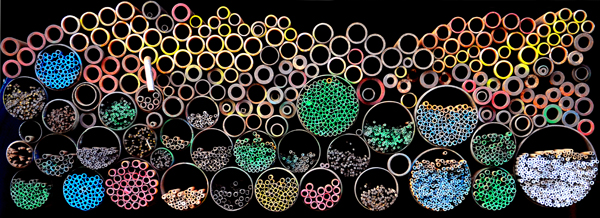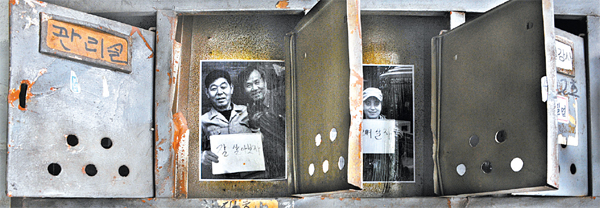Among iron foundries, a haven for artists

Stacked pipes at an iron foundry in Mullae Art Village in Mullae-dong, central Seoul, have been painted by artists, adding color to the neighborhood. [JoongAng Ilbo]
At around 2000, some of the iron foundries relocated and the government enacted a redevelopment policy after the 1997-98 Asian financial crisis. After seeing potential in Mullae’s desolate state, some young artists began flocking to the area in 2005 and created a small artistic community. Most of the artists were from Hongdae or Daehagno in central Seoul, but they set up studios in the area, drawn by cheaper rents.
Upon the artists’ entrance to the neighborhood, the industrial complex’s atmosphere has been transformed. Some of the abandoned foundries have been artistically remodeled into artists’ workspaces. Traces of their residence are found on the steel-stained walls of the two- and three-storey buildings as murals and graffiti add color to the dull neighborhood.
There are about 200 artists who are actively working in about 70 workspaces in Mullae Art Village, drawing murals on the walls, holding photo and art exhibitions, setting up installations, and holding street performances.
One of the art spaces that moved from Hongdae - the artistic part of Seoul - is the “Jaemi Gongjakso.” This cultural space, owned by a couple in their 30s, used to be next to Hongik University, offering its visitors a space to hold exhibitions, small concerts for indie bands from Hongdae and cultural workshops. It also has a small coffee bar where visitors can order drinks. But the space moved to the Mullae Art Village in March, attracted by its lower rent.
“We just moved in because of cheaper rent,” said Lee Sae-mi, owner of the Jaemi Gongjakso. “The place had been empty for many years and we were looking for a cheaper place than Hongdae, so we decided to come to Mullae. That’s probably the only reason.”
Among upcoming events at the Jaemi Gongjakso, there is “A Night of Poetry & Classic Guitar Team, VAE,” scheduled to hold a performance on Saturday.
According to Lee, its difficult for first-timers to the area to find the village’s charm, as it’s difficult to find their way around, not to mention distinguishing which area is an active artist’s workspace or just an iron foundry.

Abandoned post boxes are used to exhibit photographs. By Park Sang-moon
However, traces of artworks hidden in numerous spots is the probably the real charm of Mullae Art Village, attracting young and old visitors with cameras. In this neighborhood, old postboxes are used as a photo exhibition corner and stacked bars of steel are colorfully painted.
Artworks here are not limited to paintings or photographs. Artists in Mullae work on paintings, installation art, sculpture, design, illustration, video art, calligraphy, film, animation and other genres of visual art, including dance, theater, street performances and traditional arts.
Somssi, or Cotton Seed in English, is a nonprofit gallery-cum-cafe that opened its doors in the Mullae Art Village in 2010. It’s one of the most visited workspaces in the area, not only by the public, but by artists in the area. It’s also a space where artists like to gather together for a friendly talk.
Gallery Jungdabang Project is also popular among visitors as it not only holds exhibitions of new artists, performances and seminars but also other programs for the public, such as a pottery wheel for kids, wall painting and even wine-tasting events.
Alternative space Moon is an autonomous communal space managed by BonoboC, a culture and art group at the Mullae Arts Village. The space holds its “Art Meet Sound Project,” at 7 p.m. on the third Saturday of each month.
The owner of BonoboC, Lee So-ju, 37, established a “fair travel” program for the public, “Olle? Mullae!”
“Word of the Mullae Art Village has been spreading among Seoulites, however, I’ve heard that it is difficult for them to find art spaces that are located here and there among hundreds of iron foundries. To help them appreciate the Mullae Art Village, I decided to plan this program and guide them myself,” said Lee.
Lee was one of the first artists to enter into Mullae in 2005. When he first settled down here, there were only three workspaces for artists. This guided tour around the art village costs 10,000 won ($8.64) per person and is held on the first and third Saturdays of each month.

Paintings adorn the wooden doors of an iron foundry. [JoongAng Ilbo]
Mullae Art Festival has been held annually since 2007 and this year’s festival kicks off from Aug. 22 and runs to Sept. 2. The basic idea of the Mullae Art Festival is “to bring artists of various genres and the audience together without any boundaries and to make the artists express their creativity,” according to the festival organizing committee. During the festival, there are going to be diverse activities and exhibitions ranging from video art and street dancing to musical concerts as well as programs for the public to participate in.
As more and more artists flock into the neighborhood creating an “art village,” the Seoul Metropolitan Government decided to provide support by establishing the “Seoul Art Space - Mullae” in 2010. It’s part of the Seoul Foundation for Arts and Culture’s “Seoul Art Spaces” project, which was established to “promote the arts by reinventing unused structures as new places where young artists and the general public can satisfy their artistic interests and desires.” It already has seven and added Mullae in 2010. This four-story building consists of various supporting facilities for creating and presenting, such as a common workshop, multipurpose presentation hall, recording room and a seminar room. On the top floor, the building is equipped with nine hostel rooms and lounges for foreign artists, in an effort to provide a platform for domestic and foreign art exchanging.
The number of visitors hoping to converse with an artist and take pictures of their works has also increased drastically. Although the artists thank the public for showing interest in art, visitors who pop in at any time of the day aren’t always welcome.

Colorful lights are projected on the gray wall of a building. By Park Sang-moon
There has also been a plan that the area will become redeveloped and that the buildings will be demolished as soon as the redevelopment takes effect, which would push out many artists who found a home at the village. The artists formed a union to oppose the government’s redevelopment policy while land owners tried to take measures to make the redevelopment happen. One of the “measures” taken by the owners was to raise rents, according to the artists.
“It used to cost about 200,000 won to 250,000 won per month with about 2 to 3 million won as key money, but these days as Mullae-dong becomes more and more popular, the rents go well over 300,000 won per month,” said an artist who requested his name not to be printed. “It’s just a measure to drive out the artists by the owners to earn money.”
One other artist surnamed Lee said that he will move out as his landlord raised the monthly rent to 800,000 won, which was only 200,000 won in 2007. “This place was empty for more than 10 years but I moved in, spending my own money on water and electric works in 2007,” said Lee.
However, Lee Sae-mi from Jaemi Gongjakso was calm, saying that she doesn’t “believe the redevelopment plan will get into action in the near future.”
In an effort to revitalize the area and to help the two disparate groups - the artists and small business owners who own iron factories - to live harmoniously, Seoul Mayor Park Won-soon visited the art village recently. He held a meeting with the two groups at the alternative space Moon to talk about ways to vitalize the area and said he will “launch a mapping process of the Mullae Art Village” to allow artists and small business owners to communicate.
BY YIM SEUNG-HYE [sharon@joongang.co.kr]










with the Korea JoongAng Daily
To write comments, please log in to one of the accounts.
Standards Board Policy (0/250자)